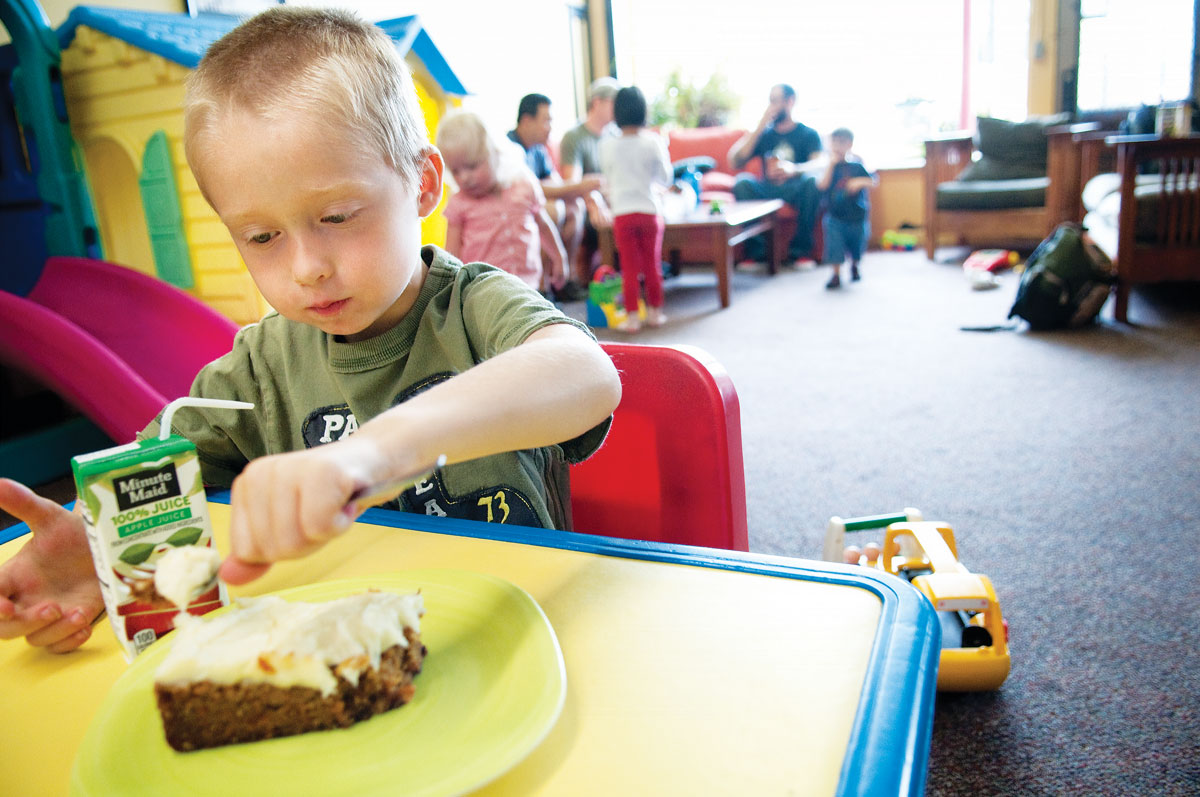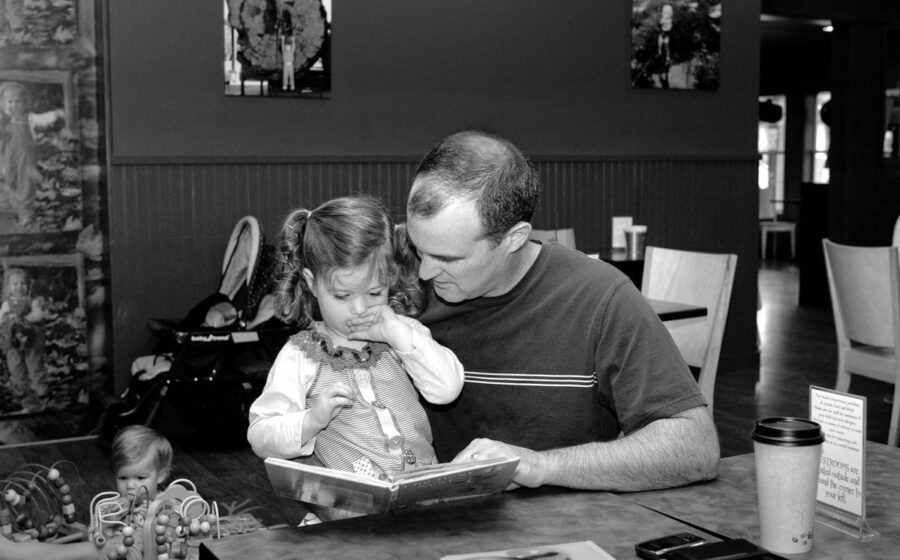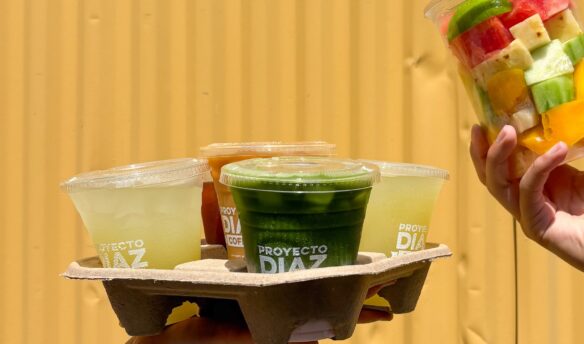[A]fter her son was born in 1995, Kris Gremmels started bringing him to work. Gremmels, the owner of Minneapolis’ Sovereign Grounds, kept a stash of storybooks and toy cars at the coffee shop to keep her barista-in-training occupied while she roasted and brewed coffee and served baked goods. To her surprise, the stockpile of toys triggered a trend: customers started bringing in their kids, and Sovereign Grounds earned a reputation as a kid-friendly coffee shop.
“At that time, there was no place for parents to take their kids,” Gremmels recalls. “We became a popular place for families to relax and hang out. Our customers started donating toys, and the play space kept growing.”
The concept proved so popular that Sovereign Grounds struggled to accommodate the number of families vying for a table. During a 2013 renovation, the coffee shop expanded its space to include a 600-square foot indoor park.
While most coffee shops are as adults-only as a shot of espresso, cafés that provide an inviting space for children and their parents offer another model in this competitive market. While the kid-approved offerings vary, the goal is the same: use a niche to help boost business.
Making Kids and Families Feel Welcome
There are multiple variations of the “stay-and-play” café. Some family-friendly coffee shops incorporate pint-sized furniture and baskets of toys into the main space, while others invest in dedicated spaces complete with mini-playgrounds for their youngest customers.
At the Green Bean in Seattle, the furniture is arranged to form a U-shaped area filled with toys, books, and games. Although children are welcome anywhere in the café, dividing the space visually encourages kids to use one area—not the entire coffee shop—as their playroom. “We envisioned a cozy coffee shop where people in the neighborhood would feel comfortable bringing their kids,” explains Randy Rowland, CEO of the Green Bean.

Four Kids Coffee in North Canton, Ohio, took a different approach, constructing an 800-square foot “creative play space” complete with soundproofing, recycled rubber flooring, and clouds painted on the walls. Four Kids Coffee requires children to remove their shoes and wash their hands before entering the space to keep the area clean and reduce the spread of germs and allergens.
Catherine Sackett, a mom of four who co-owns the coffee shop with her husband, Jason, filled the creative play space with a playhouse, train table, art supplies, books, puzzles, and games. “We wanted to encourage the good old-fashioned play that develops brain function, creativity, and socialization,” she says.
Funding Playtime
Stocking a coffee shop with pint-sized furniture and toys is expensive, especially because kids can be destructive. Rowland believes that providing supplies that foster a family-friendly atmosphere is part of the cost of doing business. While generous patrons have been known to donate toys, coloring books, or crayons, the café covers the cost of maintaining the toys and replenishing supplies.
Sovereign Grounds takes a similar approach but keeps a basket on the counter and invites customers to leave tips for toys. To increase the lifespan of the toys in the kids’ corner, Gremmels steers clear of battery-operated toys, which are difficult to clean and expensive to maintain, in favor of investing in quality toys that will last longer.
At the Village Bean in Bothell, Washington, parents pay a fee of $2.50 for children to play in the dedicated play area. Initially, it was free for kids to use the play space, but owner Karin Resing realized it took considerable resources to maintain the space.
A year after their 2009 opening, she introduced the fee, which covers the cost of maintaining the equipment. “I like to keep the fee low, so it’s affordable but still enough to help offset the cost of new toys and staff time to clean the space,” she says.
Four Kids Coffee also charges for access to its large and supervised play area. For $3.25 per half hour, kids can engage in supervised play while their parents relax with a cup of coffee. “Almost every parent pays for a half-hour thinking that their child won’t stay or that a half-hour is enough,” Sackett explains. “After about twenty minutes, you see them relax, and the stress starts to melt away, so they buy another half hour.”
No Kids Allowed
While a family-friendly coffee shop may delight parents, some patrons are turned off by the concept. “From nine a.m. to one p.m., we are the mom’s place to be—and that can be a bit overwhelming for some patrons,” Sackett admits. “Some people don’t like being in a café when there are so many kids running around, so we have to manage expectations.” With plenty of activities to keep their kids entertained, parents feel comfortable staying longer, which often translates to multiple transactions.

While some may avoid coming in for coffee during the peak toddler hours, family-friendly coffee shops insist that their customer base extends beyond moms and dads. At Four Kids Coffee, there is a separate room for meetings, and Sackett encourages those who need a quiet spot for a business meeting or study sessions to reserve the space. To ensure the family-friendly concept didn’t detract from business, the coffee shop soundproofed its playroom, and Sackett notes, “With only two exceptions in two years, you don’t hear the kids playing—until the door opens.”
Despite the lack of a separate, soundproofed room at the Green Bean, all types of coffee drinkers continue patronizing the neighborhood coffee shop. It’s common to see children playing with toys while doctoral candidates work on their dissertations—all with the buzz of coffee brewing in the background. “In this neighborhood, it’s not considered abnormal to include families in daily activities, including hanging out at the coffee shop,” Rowland says. “To me, it defies logic not to be a family-friendly place.”
Creating a welcoming place for families is also good for business. With plenty of activities to keep their kids entertained, parents feel comfortable staying longer, which often translates to multiple transactions.
“Moms order coffee and then come back to the register a little while later to buy milk and cookies or a piece of quiche for lunch,” Rowland says. “The longer you can get people to sit and relax, the more likely they are to spend more money.”
Play works up an appetite, and offering a kids’ menu is one of the primary ways family-friendly coffee shops boost their revenues. The Village Bean makes sandwiches cut into the shapes of dinosaurs, and Sovereign Grounds serves grilled cheese sandwiches and fresh fruit. All Four Kids Coffee menu items contain no dairy, soy, wheat, gluten, or eggs to accommodate children with food allergies. But for a family-friendly café to be successful, coffee must come first.
Coffee To The Front
Sovereign Grounds roasts its coffee onsite. Their flagship blends, Turkish Roast and Anatolian Roast, are produced using small batches of Fair Trade and USDA-certified organic beans in imported Turkish coffee roasters. The Green Bean serves single-origin and blended coffees from Seattle-based roasting company Caffe Lusso Coffee Roasters. The Village Bean partnered with Mukilteo Coffee Roasters to source its beans. The roaster delivers fresh beans each week and worked with Resing to create a private label brand that is served and sold at the Village Bean.
“Customers come to The Village Bean for the coffee,” Resing says. “It’s a critical element of my business.” Sackett agrees. “When we started, one thing my husband and I agreed on was that we had to serve great coffee,” she says.
Four Kids Coffee does not roast its beans; instead, the café sources its coffee from PT’s Coffee Roasting. Before opening, Catherine and Jason Sackett trained as baristas to learn different brewing methods. Their head barista has competed in several regional and national competitions, inspiring the Sacketts to continue learning the trade. Their coffee education led the couple to develop a passion for single-origin, sustainably grown coffee, which they make on a Nuova Simonelli Aurelia Competizione machine.
“For us, it’s not about being a play area serving coffee or just another coffee shop. It’s about being a great coffee shop,” Sackett says. “When people ask us what our primary business is, I tell them that we don’t have one business, we have three; they each take a unique set of skills and just happen to all be under one roof,” she adds.
Creating a successful family-friendly coffee shop is a lot like brewing the perfect cup of coffee. It requires mixing multiple elements in just the right proportions. The perfect blend includes engaging activities for kids, great food, and exceptional coffee.
Jodi Helmer is a regular contributor to Fresh Cup. Her work has appeared in Urban Farm, Entrepreneur, and National Geographic Travel. Feature image courtesy of Village Bean.
This article was originally published in the February 2015 issue of Fresh Cup Magazine. It has been edited to reflect Fresh Cup’s current editorial standards.
















